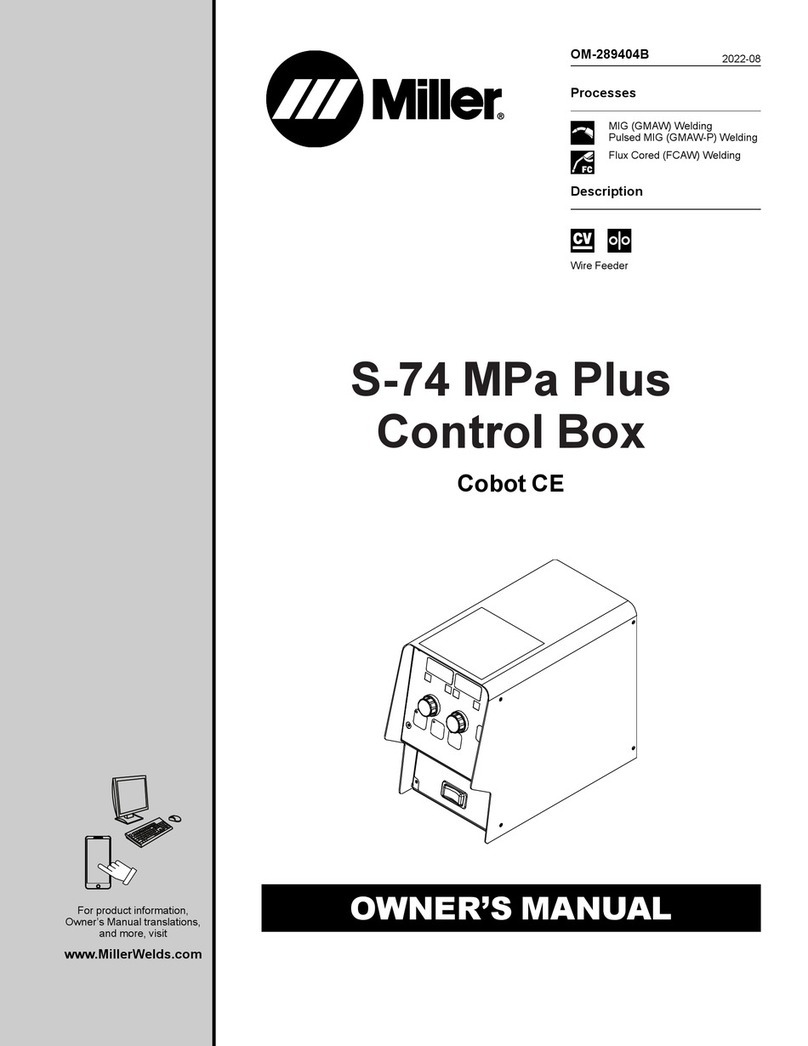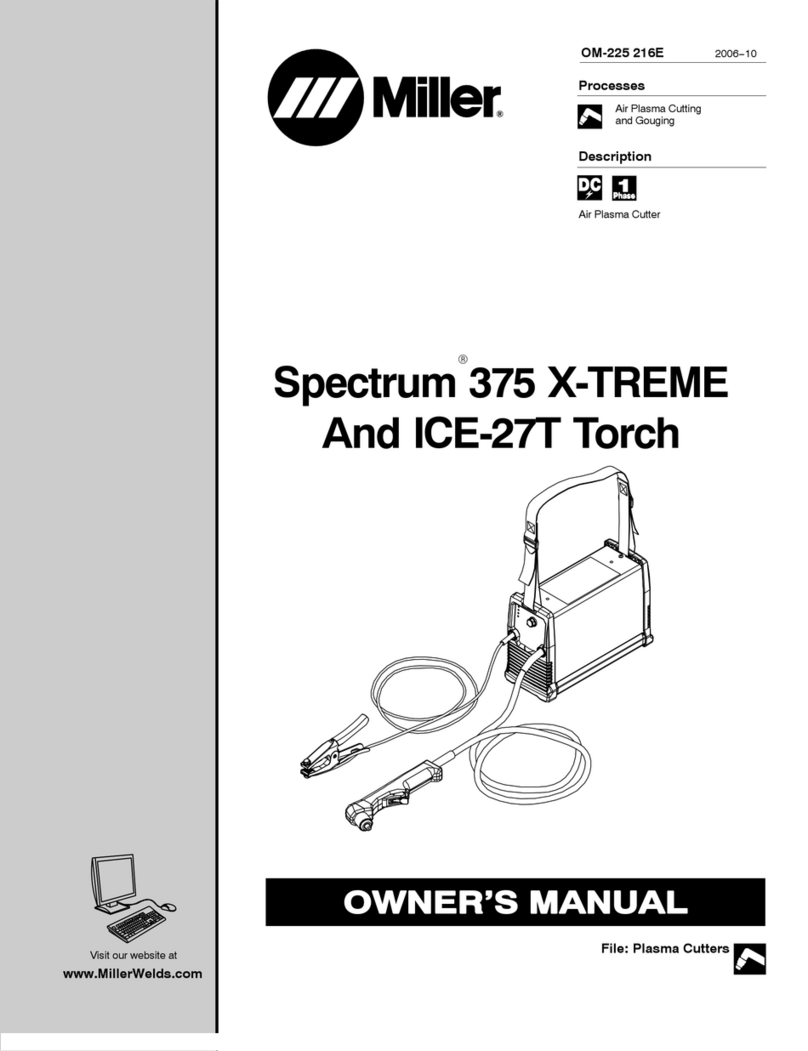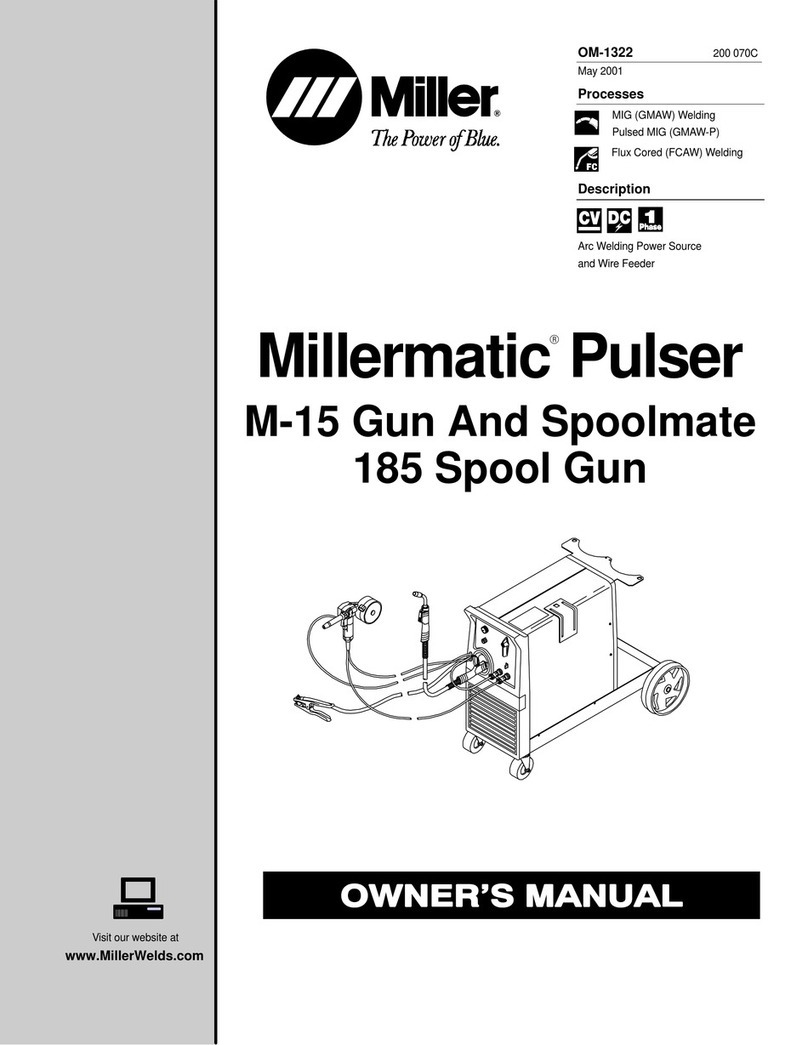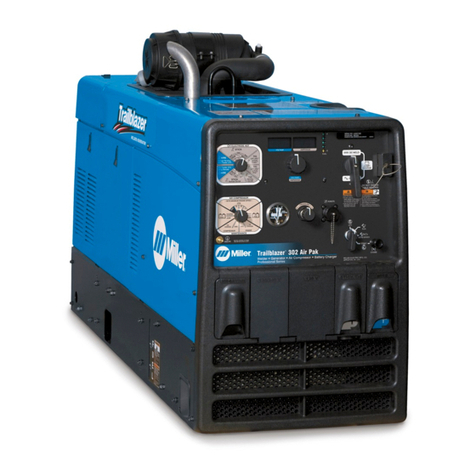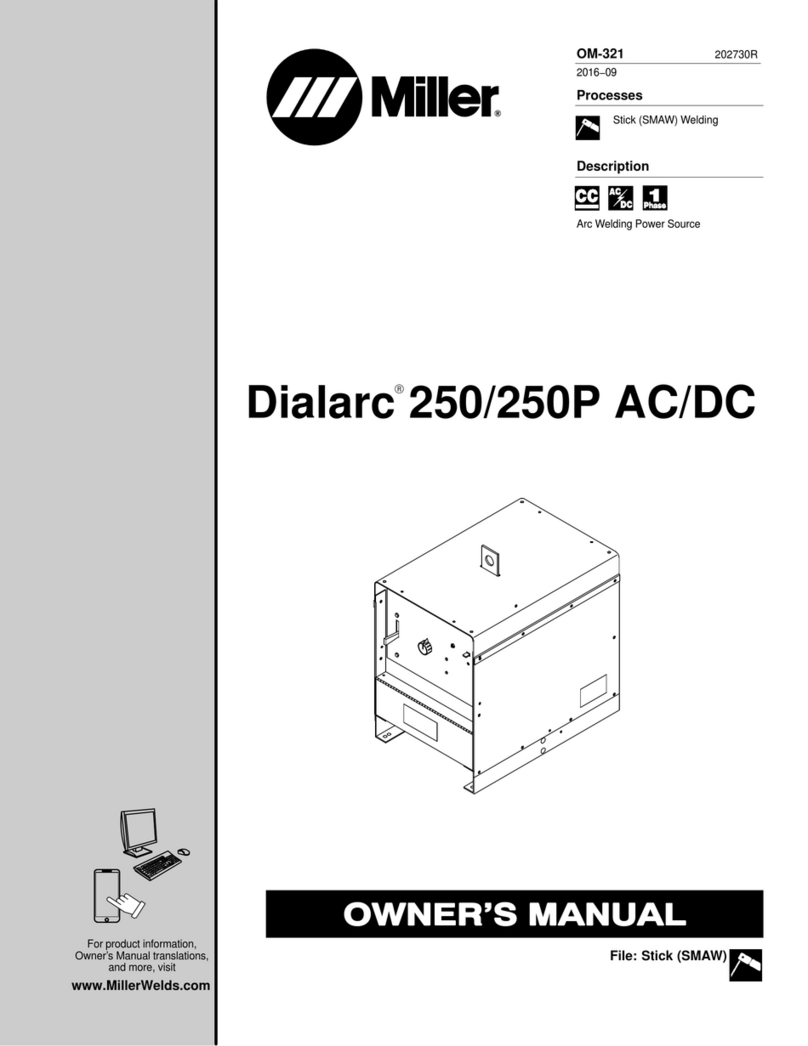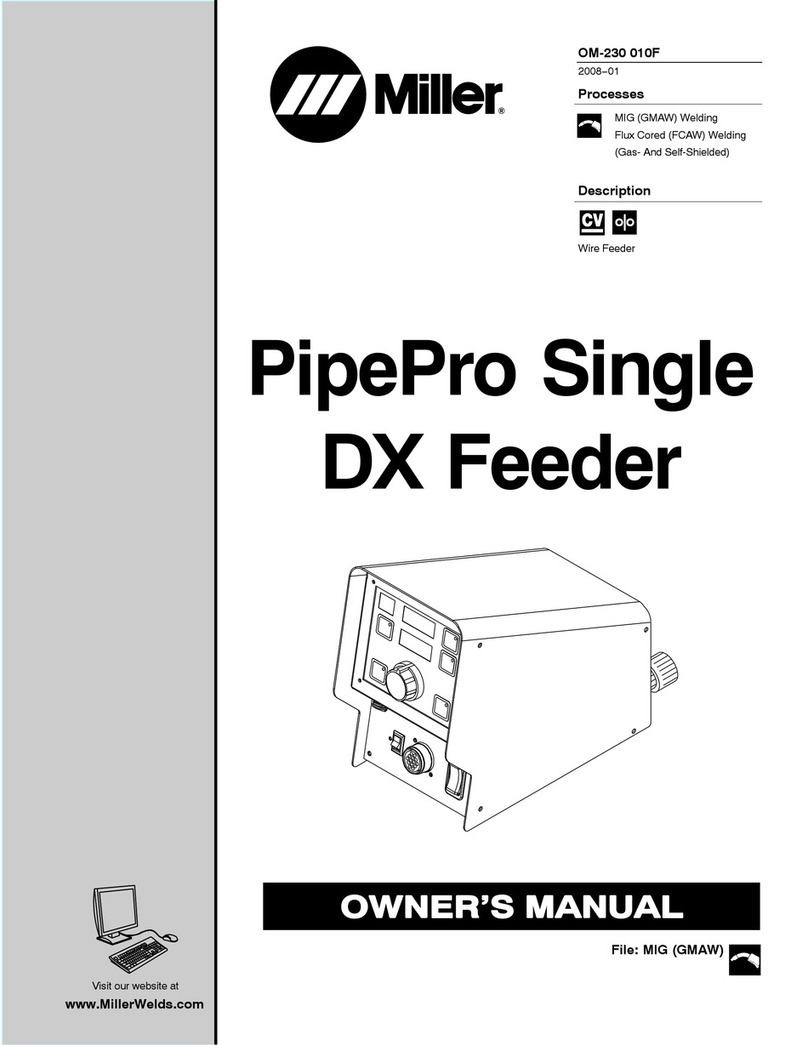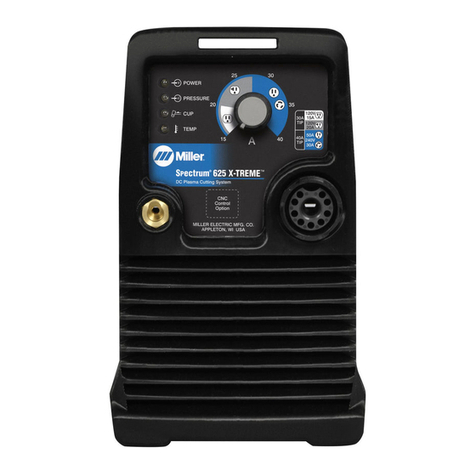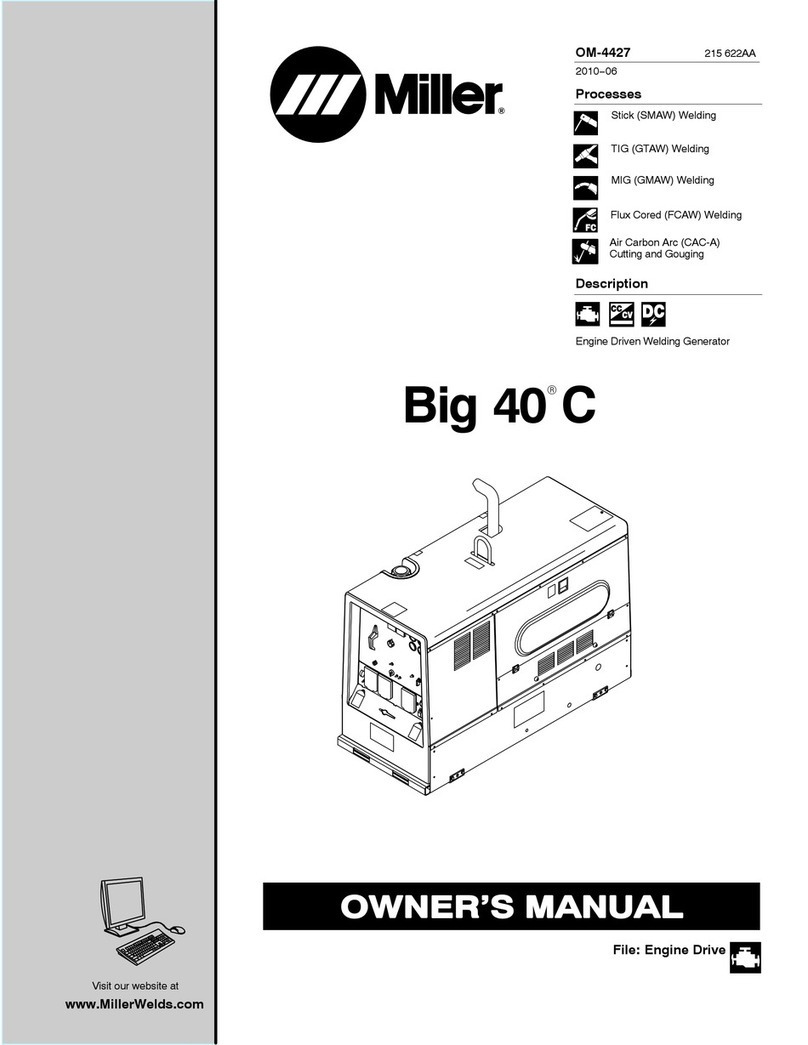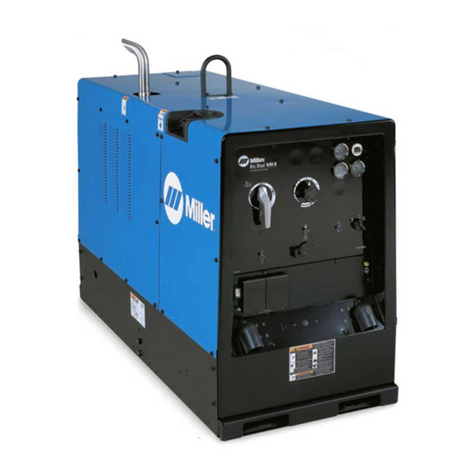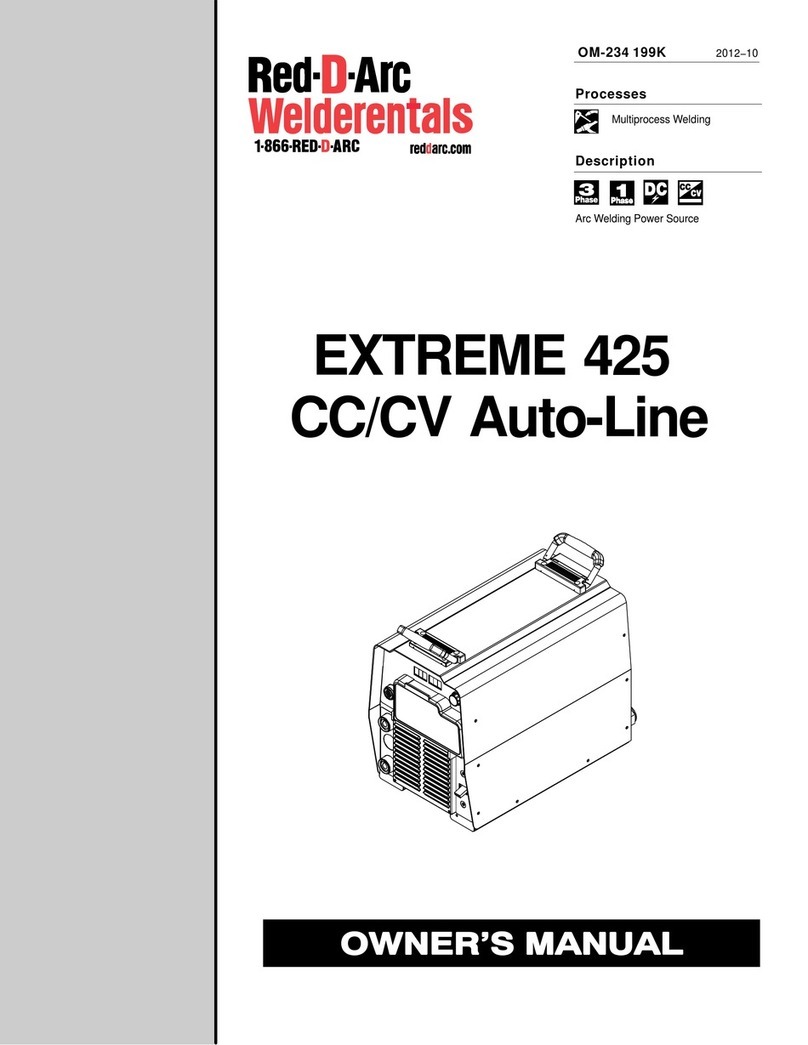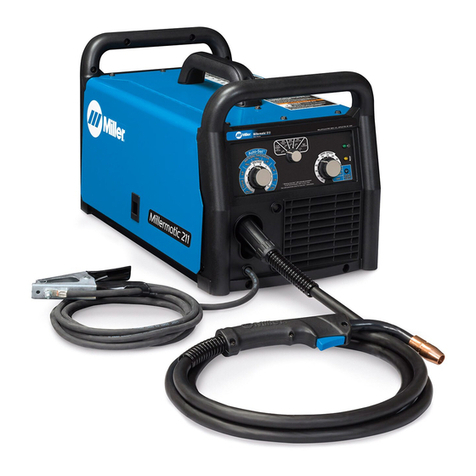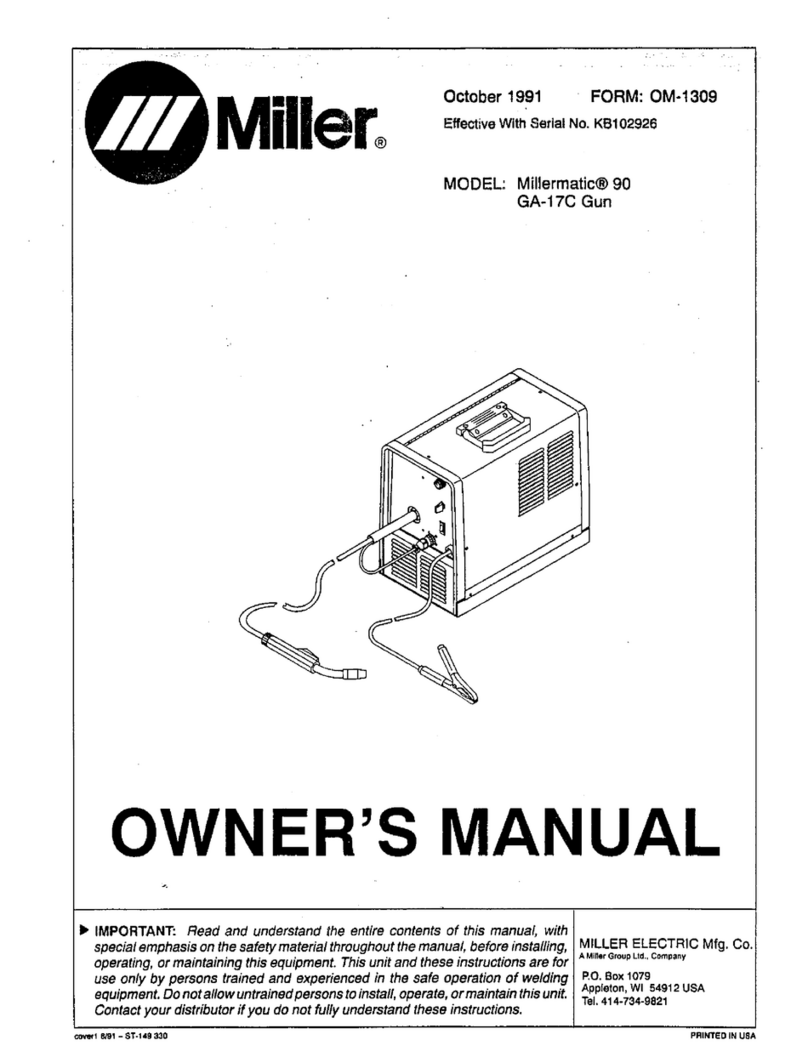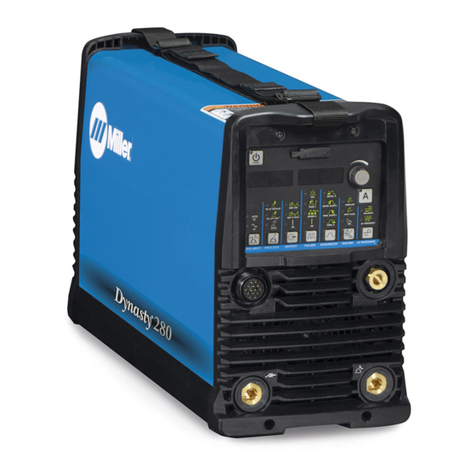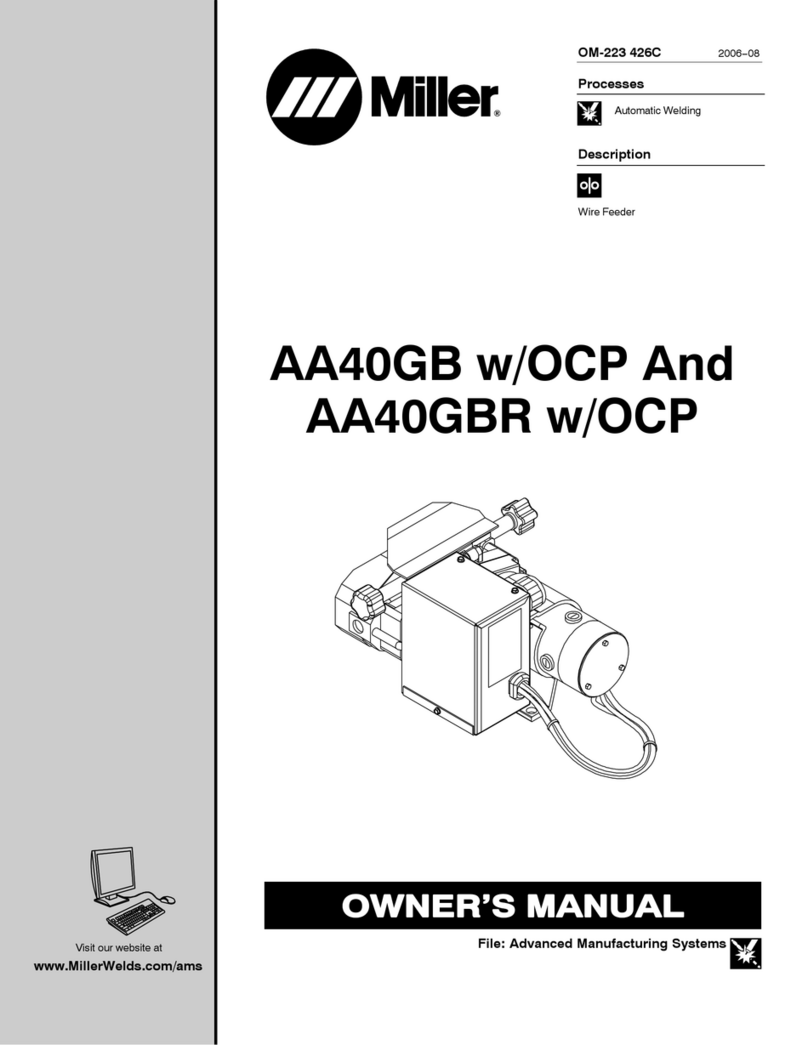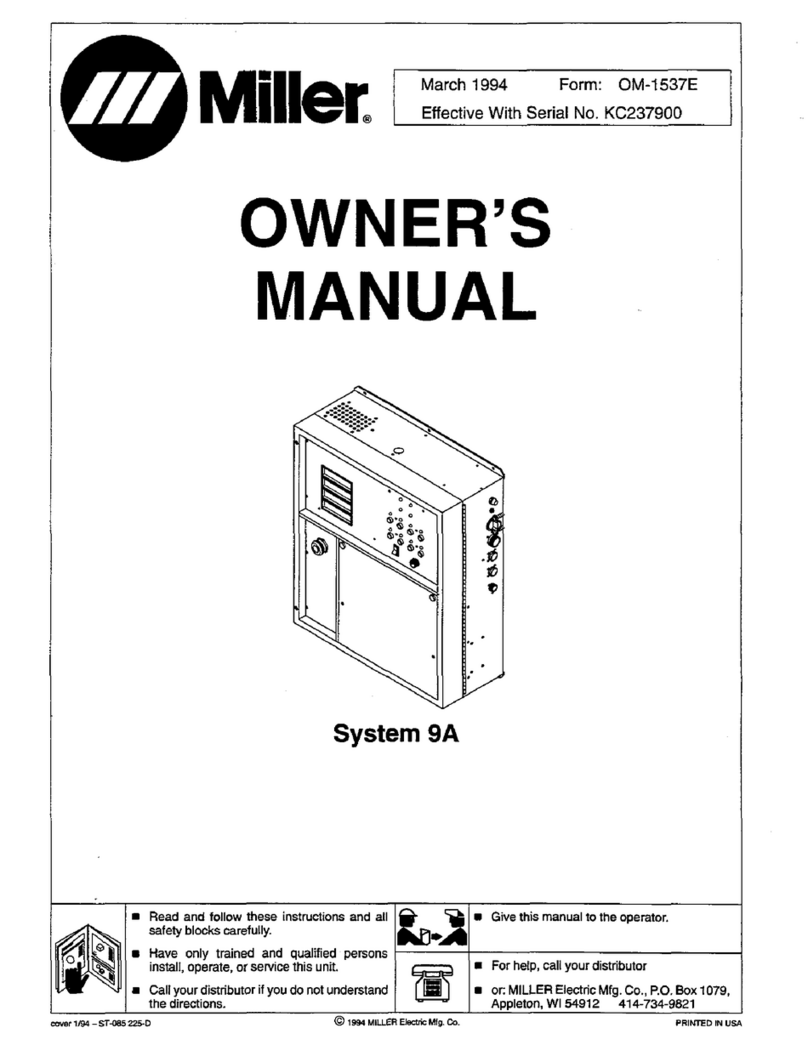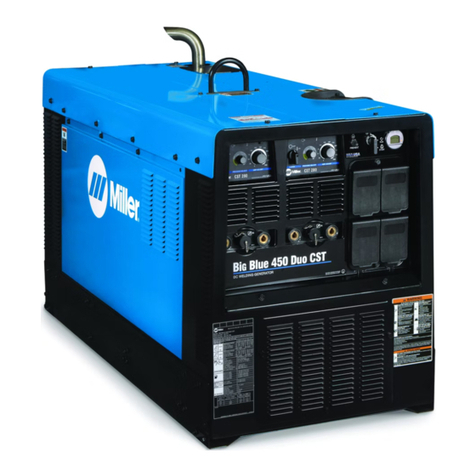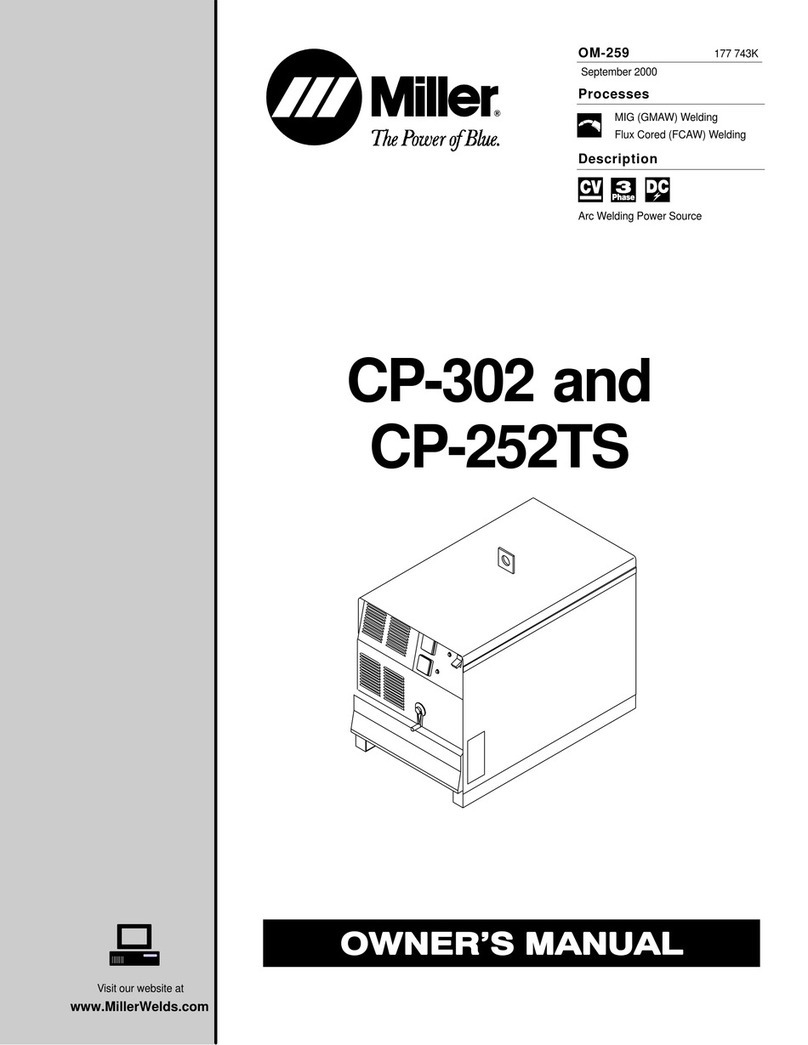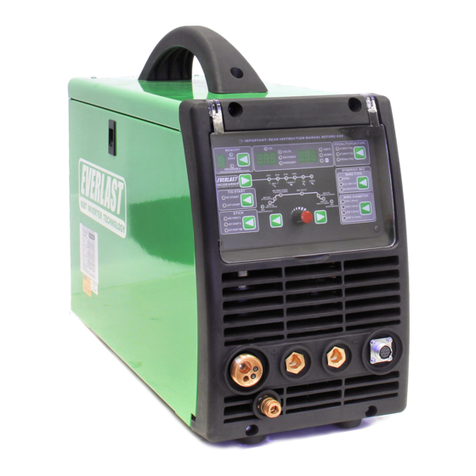
OM-249336 Page 6
ARC WELDING can cause
interference.
lElectromagnetic energy can interfere with sensitive
electronic equipment such as microprocessors,
computers, and computer-driven equipment such
as robots.
lBe sure all equipment in the welding area is electromagnetically
compatible.
lTo reduce possible interference, keep weld cables as short as
possible, close together, and down low, such as on the floor.
lLocate welding operation 100 meters from any sensitive electronic
equipment.
lBe sure this welding machine is installed and grounded according
to this manual.
lIf interference still occurs, the user must take extra measures such
as moving the welding machine, using shielded cables, using line
filters, or shielding the work area.
1-6. California Proposition 65 Warnings
WARNING – This product can expose you to chemicals in-
cluding lead, which are known to the state of California to
cause cancer and birth defects or other reproductive harm.
For more information, go to www.P65Warnings.ca.gov.
For Diesel Engines:
WARNING – Breathing diesel engine exhaust exposes you
to chemicals known to the state of California to cause can-
cer and birth defects or other reproductive harm.
ll Always start and operate the engine in a well−ventilated
area.
ll If in an enclosed area, vent the exhaust to the outside.
ll Do not modify or tamper with the exhaust system.
ll Do not idle the engine except as necessary.
For more information, go to www.P65Warnings.ca.gov/diesel.
1-7. Principal Safety Standards
Safety in Welding, Cutting, and Allied Processes, ANSI Standard
Z49.1, is available as a free download from the American Welding So-
ciety at http://www. aws. org or purchased from Global Engineering
Documents (phone: 1-877-413-5184, website: www.global.ihs.com).
Safe Practices for the Preparation of Containers and Piping for Weld-
ing and Cutting, American Welding Society Standard AWS F4.1, from
Global Engineering Documents (phone: 1-877-413-5184, website:
www.global.ihs.com).
Safe Practices for Welding and Cutting Containers that have Held
Combustibles, American Welding Society Standard AWS A6.0, from
Global Engineering Documents (phone: 1-877-413-5184, website:
www.global.ihs.com).
National Electrical Code, NFPA Standard 70, from National Fire Pro-
tection Association, Quincy, MA 02169 (phone: 1-800-344-3555, web-
site: www.nfpa.org and www.sparky.org).
Safe Handling of Compressed Gases in Cylinders, CGA Pamphlet P-
1, from Compressed Gas Association, 14501 George Carter Way,
Suite 103, Chantilly, VA 20151 (phone: 703-788-2700,website:www.
cganet.com).
Safety in Welding, Cutting, and Allied Processes, CSA Standard
W117.2, from Canadian Standards Association, Standards Sales,
5060 Spectrum Way, Suite 100, Mississauga, Ontario, Canada L4W
5NS (phone: 800-463-6727, website: www.csagroup.org).
Battery Chargers, CSA Standard C22.2 NO 107.2-01, from Canadian
Standards Association, Standards Sales, 5060 Spectrum Way, Suite
100, Mississauga, Ontario, Canada L4W 5NS (phone: 800-463-6727,
website: www.csagroup.org).
Safe Practice For Occupational And Educational Eye And Face Pro-
tection, ANSI Standard Z87.1, from American National Standards In-
stitute, 25 West 43rd Street, New York, NY 10036 (phone: 212-642-
4900, website: www.ansi.org).
Standard for Fire Prevention During Welding, Cutting, and Other Hot
Work, NFPA Standard 51B, from National Fire Protection Association,
Quincy, MA 02169 (phone: 1-800-344-3555, website: www.nfpa.org.)
OSHA, Occupational Safety and Health Standards for General Indus-
try, Title 29, Code of Federal Regulations (CFR), Part 1910.177 Sub-
part N, Part 1910 Subpart Q, and Part 1926, Subpart J, from U. S.
Government Printing Office, Superintendent of Documents, P.O. Box
371954, Pittsburgh, PA 15250-7954 (phone: 1-866-512-1800) (there
are 10 OSHA Regional Offices—phone for Region 5, Chicago, is 312-
353-2220, website: www.osha.gov).
Portable Generators Safety Alert, U. S. Consumer Product Safety
Commission (CPSC), 4330 East West Highway, Bethesda, MD 20814
(phone: 301-504-7923, website: www.cpsc.gov).
Applications Manual for the Revised NIOSH Lifting Equation, The Na-
tional Institute for Occupational Safety and Health (NIOSH), 1600 Clif-
ton Rd, Atlanta, GA 30329-4027 (phone: 1-800-232-4636, website:
www.cdc.gov/NIOSH).
For Standards regulating hydraulic systems, contact the National Flu-
id Power Association, 6737 West Washington St., Suite 2350, Milwau-
kee, WI 53214 (phone: (414) 778-3344, website: www.nfpa.com).
Battery Service Manual, Battery Council International, 330 North Wa-
bash Ave., Suite 2000, Chicago IL 60611 (phone: 1-312-245-1074,
website: www.batterycouncil.org).
ROM 2018–06
1-8. EMF Information
Electric current flowing through any conductor causes localized elec-
tric and magnetic fields (EMF). The current from arc welding (and al-
lied processes including spot welding, gouging, plasma arc cutting,
and induction heating operations) creates an EMF field around the
welding circuit. EMF fields can interfere with some medical implants,
e.g. pacemakers. Protective measures for persons wearing medical
implants have to be taken. For example, restrict access for passers
−by or conduct individual risk assessment for welders. All welders
should use the following procedures in order to minimize exposure to
EMF fields from the welding circuit:
1. Keep cables close together by twisting or taping them, or using a
cable cover.
2. Do not place your body between welding cables. Arrange cables
to one side and away from the operator.
3. Do not coil or drape cables around your body.
4. Keep head and trunk as far away from the equipment in the weld-
ing circuit as possible.
5. Connect work clamp to workpiece as close to the weld as
possible.
6. Do not work next to, sit or lean on the welding power source.
7. Do not weld whilst carrying the welding power source or wire
feeder.
About Implanted Medical Devices:
Implanted Medical Device wearers should consult their doctor and the
device manufacturer before performing or going near arc welding,
spot welding, gouging, plasma arc cutting, or induction heating opera-
tions. If cleared by your doctor, then following the above procedures
is recommended.
